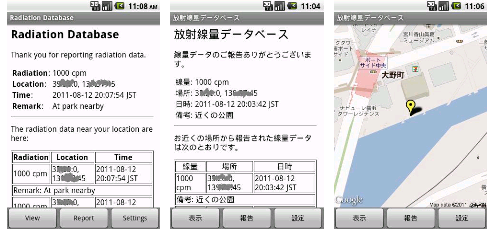 Radiation Database
Radiation Database
This product is not online any more: no demo server is operating, no demo apps are provided.
It is possible to offer this technology after fitting to your requirement.
Please call.
Radiation data submission database is supported by volunteer reporters.
You can view and report nearby radiation data with your smartphone.
This applicaiton lets you view and report radiation data at your location using a mobile device such as a smartphone or tablet. The radiation database depends on reporters with a radiation measurement device such as a Geiger-Muller counter who can contribute nearby radiation data.

You can view radiation data in the range of 18.5km from your location within ten days. This data are ones submitted by reporters using this application.
If you have a radiation measurement device, report the measured data at your nearby location periodically. The data will be stored in the database along with the location, device number and submission time.
Note: You can freely test submission of your data. You don't have to hesitate. But at that time, please add "Test" in "Remark" field.
Participation by many reporters are welcome.
The radiation database can be used by anyone who is interested in day-to-day radiation status. There are three participants to this database:
Any user of this application can view the recent radiation data near your location reported by reporters.
Please become a reporter if you have any radiation measurement device such as a Geiger-Muller counter to contribute your nearby radiation data to be shared by viewers of interest.
Kobu.Com provides this service for free and welcome a lot of reporters and viewers to participate.
Disclaimer: Please note neither continuation of this service nor accuracy of the radiation data are guaranteed.
This application handles some numerical values.
Display format of a latitude or longitude is as follows:
degree:minute:second.fraction
For example, the latitude of the Tokyo railway station is about 35 degrees, 40 minutes and 50 seconds, thus it is represented as "35:40:50". A minus sign is prefixed to a south latitude. No or plus sign is prefixed to a north latitude.
The same applies to a longitude. The longitude of the Tokyo station is about 139 degrees and 46 minutes, thus it is represented as "139:46:00". An east longitude is positive while west longitude is negative.
Input format of a latitude and longitude is the real number format as shown below. You can also use the degree-minute-second format described above.
degree.fraction
For example, the latitude and longitude of the Tokyo station is about 35.680555 and 139.766667 respectively. This format is used in a Google Maps link. A minus sign is prefixed to a south latitude or west longitude.
You can convert between the real number format and degree-minute-second format in the following way:
fraction of a degree in real number format = minute x 1/60 + second x 1/3600
The unit of altitude is in meters.
This application allows a reporter to use one of three major units described below or an artibtary unit to state a radiation value. You can use any unit provided you also provide the unit in use.
cpm (count per minutes)
A geiger counter counts the number of particles of radioactive materials that reached the Geiger tube in a certain period of time.
usv (micro sievert)
Sievert is a unit for representing a degree of influence of radiation to a living object in a certain period of time.
The "u" means "micro". A thousand microsievert is one millisievert.
I would use 35 nanosievert (nsv) instead of 0.035 microsievert which is used in mass media and official announcement.
bq (becquerel)
Becquerel is used to represent an amount of radioactive materials that emit radiation.
The Radiation Database is built for demonstration of ID Kicker for Smartphones, a product developed by Kobu.Com.
ID Kicker provides interoperation between a smartphone or tablet application and a cloud-style Internet service.
There is a product called ID Kicker for RFID for integrating a smart card (such as RFID) and a Web site too.
Contact Kobu.Com if you, investor, integrator, developer and distributor, are interested in ID Kicker.
